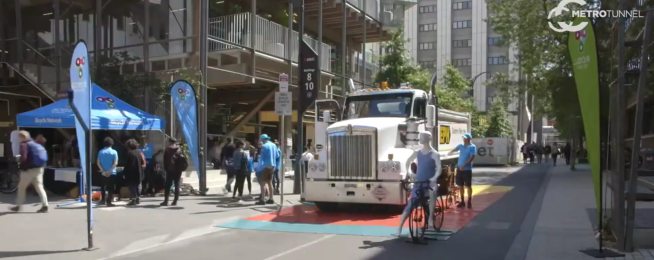The massive infrastructure boom that is putting thousands of construction trucks on urban roads has years more to run, with COVID recovery investment now flowing into the construction pipeline.
This makes it even more important to continue the planning, training and equipping needed to keep vulnerable road users out of harms way.
Fortunately we can report that so far, so good — at least for Melbourne.
Despite all the heavy vehicles associated with the tunnel projects, the level crossings removals and the road upgrades, the road safety management has worked.
Not only that, the advances have spread out across industry sectors and across the nation.
And bike riders have made a vital contribution. Bicycle Network, right at the outset of the Metro Tunnel project, was able to obtain a commitment that next-generation safety requirements would be part of the contracts for the project.
And it wasn’t long before that commitment was extended to all the large projects the Victorian Government embarked upon.
Now the Victorian Department of Transport has created a webpage with resources "developed over the past three years to help state and local government, developers and utilities better manage their construction projects and the construction industry improve delivery, with more consideration for vulnerable road users."
The webpage represents the collation of a number of years of project development and multi-organisation working group effort, involving government, private sector, NGO's, consultancies and community organisations.
The working groups came together to work on a number of topics related to improving Vulnerable Road User safety, including:
- Truck standards
- Truck driver training
- Traffic Management Planning
- Route selection
- Communications and publicity
For example the site highlights the development of the following truck safety feature recommendations for construction trucks used at construction sites:
- Trucks should have side under-run protection
- The truck’s front, rear and side blind-spots should be eliminated or minimised through the use of visual aids, sensors and audible or visual alerts
- Trucks should be fitted with audible indicators to alert other road users when they’re turning left
- Trucks should display prominent signage warning people of the dangers of travelling too close to trucks
- Increase conspicuity with the use of fluorescent and retroflective tape outlining the body of the truck and trailer, and increasing the visibility of the drawbar.
- Trucks should protect the air quality of vulnerable road users by achieving a minimum of Euro 4, but preferably Euro 5 or above.
Become our friend
Find out more about Bicycle Network and support us in making it easier for people to ride bikes.


